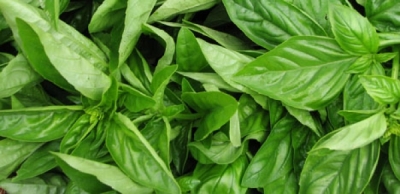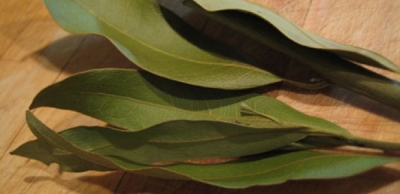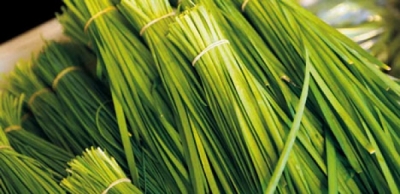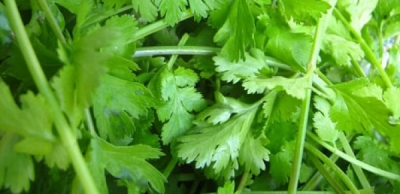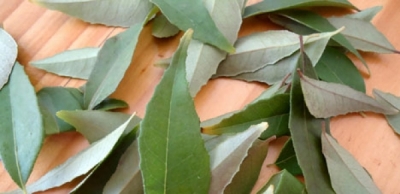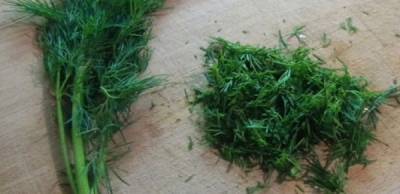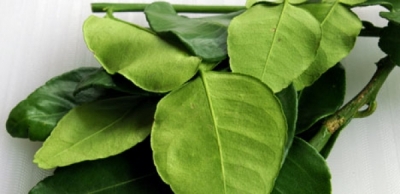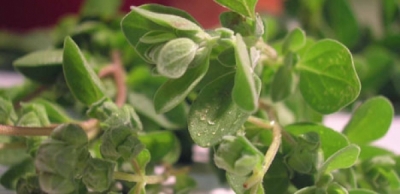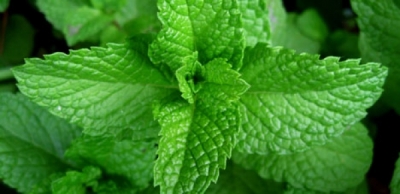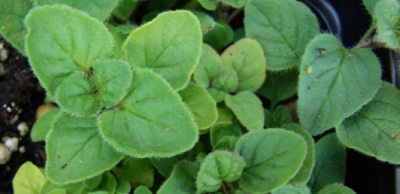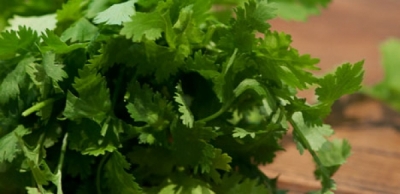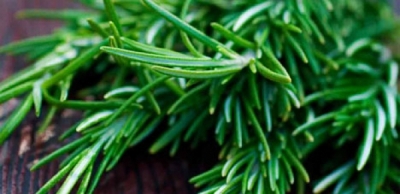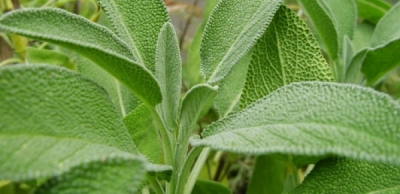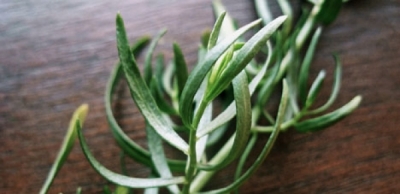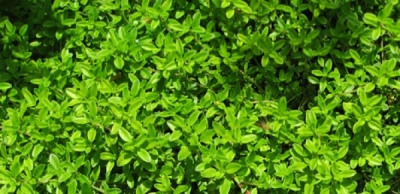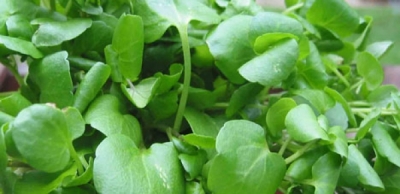Deprecated: Methods with the same name as their class will not be constructors in a future version of PHP; plgContent123ContactForm has a deprecated constructor in /home/butlerma/public_html/howtoherbs.com/plugins/content/123contactform/123contactform.php on line 15
Herbipedia
Basil
Called the "royal herb" by ancient Greeks, this annual is a member of the mint family. Fresh basil has a pungent flavour that some describe as a cross between licorice and cloves. It's a key herb in Mediterranean cooking, essential to the delicious Italian pesto. Most varieties of basil have green leaves, but one "opal basil" is a beautiful purple color. Lemon basil and cinnamon basil have green leaves but their perfume fragrance and flavour matches their respective names.
Basil is a summer herb but can be grown successfully inside during the winter in a sunny window. It's plentiful during summer months and available year-round. Choose evenly colored leaves with no sign of wilting. Refrigerate basil, wrapped in barely damp paper towels and then in a plastic bag, for up to 4 days. Or store a bunch of basil, stems down, in a glass of water with a plastic bag over the leaves. Refrigerate in this manner for up to a week, changing the water every 2 days.
To preserve fresh basil, wash and dry the leaves and place layers of leaves, then coarse salt, in a container that can be tightly sealed. Alternatively, finely chop the cleaned basil and combine it with a small amount of olive oil. Freeze in tiny portions to flavour sauces, salad dressings.
Bay Leaves
Also called laurel leaf or bay laurel, this aromatic herb comes from the evergreen bay laurel tree, native to the Mediterranean. Early Greeks and Romans attributed magical properties to the laurel leaf and it has long been a symbol of honor, celebration and triumph, as in "winning your laurels."
The two main varieties of bay leaves are Turkish (which has 1- to 2-inch-long oval leaves) and Californian (with narrow, 2- to 3-inch-long leaves). The Turkish bay leaves have a more subtle flavour than do the California variety. Bay leaves are used to flavour soups, stews, vegetables and meats. They're generally removed before serving. Overuse of this herb can make a dish bitter.
Chives
Related to the onion and leek, this fragrant herb has slender, vivid green, hollow stems. Chives have a mild onion flavour and are available fresh year-round. Look for those with a uniform green color and no signs of wilting or browning. Store in a plastic bag in the refrigerator up to a week. Fresh chives can be snipped with scissors to the desired length. They're delicious in many cooked dishes but should be added toward the end of the cooking time to retain their flavour. Both chives and their edible lavender flowers are a tasty and colorful addition to salads. Chives are a good source of vitamin A and also contain a fair amount of potassium and calcium.
Coriander
Native to the Mediterranean and the Orient, coriander is related to the parsley family. Fresh coriander leaves have an extremely pungent odor and flavour that lends itself well to highly seasoned food. Though it's purported to be the world's most widely used herb, many Americans and Europeans find that fresh coriander is definitely an acquired taste.
Choose leaves with an even green color and no sign of wilting. Store a bunch of coriander, stems down, in a glass of water with a plastic bag over the leaves. Refrigerate in this manner for up to a week, changing the water every 2 days. Coriander leaves are used widely in the cuisines of India, Mexico, the Orient and the Caribbean.
Curry Leaves
From a plant native to southern Asia, this fragrant herb looks like a small, shiny lemon leaf and has a pungent curry fragrance. Its flavour is essential in a substantial percentage of East Indian fare. Choose those that are bright green, with no sign of yellowing or wilting. They can be refrigerated in an airtight container up to 2 weeks.
Dill
Thought by 1st-century Romans to be a good luck symbol, dill has been around for thousands of years. This annual herb grows up to a height of about 3 feet and has feathery green leaves called dill weed, marketed in both fresh and dried forms. The distinctive flavour of fresh dill weed in no way translates to its dried form. Fresh dill does, however, quickly lose its fragrance during heating, so should be added toward the end of the cooking time. Dill weed is used to flavour many dishes such as salads, vegetables, meats and sauces.
Marjoram
Early Greeks wove marjoram into funeral wreaths and planted it on graves to symbolize their loved ones' happiness both in life and beyond. There are many species of this ancient herb, which is a member of the mint family. The most widely available is sweet marjoram, usually simply called "marjoram." It has oval, inch-long, pale green leaves and a mild, sweet, oregano like flavor. In fact, wild marjoram is another name for oregano.
Marjoram is available fresh in some produce markets and supermarkets with large fresh-herb sections. Marjoram can be used to flavour a variety of foods, particularly meats (especially lamb and veal) and vegetables. Because marjoram's flavour is so delicate, it's best added toward the end of the cooking time so its essence doesn't completely dissipate.
Mint
Long a symbol of hospitality, Greek mythology claims that mint was once the nymph Mentha. She angered Pluto's wife Persephone, who turned her into this aromatic herb. There are over 30 species of mint, the two most popular and widely available being peppermint and spearmint. Peppermint is the more pungent of the two. It has bright green leaves, purple-tinged stems and a peppery flavor. Spearmint leaves are gray-green or true green and have a milder flavour and fragrance.
It's most plentiful during summer months but many markets carry it year-round. Choose leaves that are evenly colored with no sign of wilting. Store a bunch of mint, stems down, in a glass of water with a plastic bag over the leaves. Refrigerate in this manner for up to a week, changing the water every 2 days. Mint is used in both sweet and savory dishes and in drinks such as the famous mint julep.
Oregano
Greek for "joy of the mountain," this herb sometimes called wild marjoram, belongs to the mint family and is related to both marjoram and thyme. Oregano is similar to marjoram but is not as sweet and has a stronger, more pungent flavor and aroma. Because of its pungency, it requires a bit more caution in its use.
Mediterranean oregano is milder than the Mexican variety, which is generally used in highly spiced dishes. Choose bright-green, fresh-looking bunches with no sign of wilting or yellowing. Refrigerate in a plastic bag for up to 3 days. Oregano goes extremely well with tomato-based dishes and is a familiar pizza herb.
Parsley/Continental Parsley
In ancient times parsley wreaths were used to ward off drunkenness — though proof of their efficacy in that capacity is scarce. Today, this slightly peppery, fresh-flavored herb is more commonly used as a flavoring and garnish. Though there are more than 30 varieties of this herb, the most popular are curly-leaf parsley and the more strongly flavored continental or flat-leaf parsley. Fresh curly leaf parsley and continental parsley is widely available year-round.
Parsley is sold in bunches and should be chosen for its bright-green leaves that show no sign of wilting. Wash fresh parsley, shaking off excess moisture, and wrap first in paper towels, then in a plastic bag. Refrigerate for up to a week. Dried parsley is available in the spice section of most supermarkets but bears little resemblance to the flavour of fresh. Parsley is an excellent source of vitamins A and C.
Rosemary
Used since 500 B.C., rosemary is native to the Mediterranean area (where it grows wild) but is now cultivated throughout the world. Early on, this mint-family member was used to cure ailments of the nervous system. Rosemary's silver-green, needle-shaped leaves are highly aromatic and their flavour hints of both lemon and pine.
This herb is available in whole-leaf form (fresh and dried) as well as powdered. Rosemary essence is used both to flavour food and to scent cosmetics. Rosemary can be used as a seasoning in a variety of dishes including fruit salads, soups, vegetables, meat (particularly lamb), fish and egg dishes, stuffing's and dressings.
Sage
This native Mediterranean herb has been enjoyed for centuries for both its culinary and medicinal uses. The name comes from a derivative of the Latin salvus, meaning "safe," a reference to the herb's believed healing powers. The narrow, oval, gray-green leaves of this pungent herb are slightly bitter and have a musty mint taste and aroma. Small bunches of fresh sage are available year-round in many supermarkets.
Choose sage by its fresh color and aroma. Refrigerate wrapped in a paper towel and sealed in a plastic bag for up to 4 days. Dried sage comes whole, rubbed (crumbled) and ground. It should be stored in a cool, dark place for no more than 6 months. Sage is commonly used in dishes containing pork, cheese and beans, and in poultry and game stuffing's. Sausage makers also frequently use it to flavour their products.
Tarragon
Narrow, pointed, dark green leaves distinguish this perennial aromatic herb known for its distinctive anise like flavour. Tarragon is widely used in classic French cooking for a variety of dishes including chicken, fish and vegetables, as well as many sauces, the best known being béarnaise. It's also an integral ingredient in various herbal combinations such as fines herbs. Care should be taken when using tarragon since its assertiveness can easily dominate other flavours.
Thyme/Lemonthyme
There are several varieties of this mint-family member, a perennial herb native to southern Europe and the Mediterranean. Garden thyme, the most often used variety, is a bush with gray-green leaves giving off a pungent minty, light-lemon aroma. Other varieties include the narrow-leafed French thyme and broad-leafed English thyme.
The most well-known other variety of wild thyme - a thick ground cover - is lemon thyme , an herb with a more pronounced lemon aroma than garden thyme. Whatever the variety, thyme is widely used in cooking to add flavour to vegetables, meat, poultry and fish dishes, soups and cream sauces. It's a basic herb of French cuisine and integral to bouguet garni. Fresh As with all herbs, thyme should be stored in a cool, dark place for no more than 6 months.
Watercress
Cool running water is the growing ground for this member of the mustard family, which can often be found in the wild in and around streams and brooks. Watercress has small, crisp, dark green leaves. Its pungent flavour is slightly bitter and has a peppery snap. Choose crisp leaves with deep, vibrant color. There should be no sign of yellowing or wilting. Refrigerate in a plastic bag (or stems-down in a glass of water covered with a plastic bag) for up to 5 days. Wash and shake dry just before using. Watercress may be used in salads, sandwiches, soups and a variety of cooked dishes. It's also a popular garnish, fast replacing the ubiquitous parsley.
